Study on the mechanism of Shenling Baizhu Powder in the treatment of diarrhea-type irritable bowel syndrome based on network pharmacology and molecular docking
Mei-Hua Liao, Tao Zhang, Dong-Ping Lai, Wu Yang, Ming-Jian Ding
1. Guangxi University of Chinese Medicine, Nanning 530011, China
2. Ruikang Hospital Affiliated to Guangxi University of Chinese Medicine, Nanning 530011, China
ABSTRACT Objective: Explore the possible intervention mechanism of Shenling Baizhu Powder on IBS-D from network data through network pharmacology and molecular docking simulation technology. Methods: Establish a complete regulatory network of Shenling Baizhu powder on IBS-D after obtaining the active components and drug targets of Shenling Baizhu Powder on the TCMSP platform and obtaining the disease targets of IBS-D from GeneCards and OMIM databases. Then screen out the potential best target of Shenling Baizhu Powder in IBS-D intervention network combining with the PPI network constructed in the STRING database,and screen the potential core of compounds through the molecular docking simulation and comparison with pivecurium bromide. After that,the related gene ontology functions and pathways of Shenling Baizhu Powder in treating IBS-D will be obtained though gene ontology(GO) enrichment analysis through DAVID database and Kyoto encyclo-pedia of genes and genomes(KEGG) pathways enrichment analysis through Bioconductor database. Results:The number of IBS-D disease-related targets was 2,724. And there were 184 active compounds in Shenling Baizhusan, among which 175 could act on IBS-D. After screening, four potential best targets of PTGS2, ESR1, AR and MAPK14 were obtained, and four core compounds of quercetin, luteolin, kaempferol and isorhamnetin were obtained by molecular docking simulation.GO enrichment analysis results showed that there were 92 biological processes,18 cellular components and 21 molecular functions associated with shenling Baizhu Powder intervention IBS-D process. The results of KEGG pathway enrichment analysis showed that shenling Baizhu Powder had 172 pathways involved in the intervention of IBS-D. Conclusion:The intervention effect of Shenling Baizhu powder on IBS-D was better than pivecurium bromide in terms of the number of targets and the ease of binding to the targets.Its intervention process of IBS-D may be closely related to inflammation, cancer, endocrine disorders and other related reactions and pathways, among which quercetin, luteolin, kaempferol and isorrine are the most potential core compounds in the intervention network, and the four target proteins of PTGS2, ESR1, AR and MAPK14 are the potential best target options in the intervention network.
Keywords:Shenling baizhu powder Irritable bowel syndrome Network pharmacology Molecular docking
1. Introduction
There is a saying in Chinese medicine "no dampness, no leakage".Wang Shuhe said: "Much moisture in the human body can cause diarrhea";"Jing Yue Quan shu" said: "the root of catharsis, all due to the spleen and stomach, diarrhea needs solid spleen diuresis".Spleen deficiency and dampness are the main pathogenesis of diarrhea.In“Shen Zhai's Yi Shu”, it is said that "if all diseases do not recover,they will be found in the spleen and stomach". “Synopsis of the Golden Chamber” said: "the spleen is flourishing in the four seasons and is not affected by evil".Therefore, the application of traditional Chinese medicine to treat diarrhea mostly starts from "invigorating the spleen and benefiting dampness".And Shenlingbaizhu Powder come from the "taiping huimin and dose of pharmacopoeia”, which from the four gentlemen soup plus yam, white lentils, lotus meat,coix seed, Amomum kernel, platycodon platycodon, and then combined with the dried tangerine or orange peel.It is beneficial to qi, spleen, moistening and diarrhea, and it has a positive effect on treating irritable bowel syndrome (IBS-D) [1-2].The mechanism of Shenling Baizhu Powder's intervention in IBS is still not clear,and previous studies were monomer or fragment studies without forming a network, which is not conducive to systematic new drug development.This paper uses network pharmacology, molecular docking and other methods to explore the possible mechanism of Shenling Baizhu Powder's intervention in IBS, and provides ideas for new drug development and the modernization of traditional Chinese medicine.
2. Data sources and analysis methods
2.1 Active compound and effective target screening
This study using a Chinese medicine pharmacology and analysis platform CMSP (http://tcmspw.com/ tcmsp.php) to screen out the qualified compounds(active compounds)of each component of Shenling Baizhu Powder under the conditions that bioavailability index (OB) ≥30% and drug-like index (DL)≥0.18 as recommended by the website, at the same time, from the corresponding drug Related Targets section to collect out the formula involves all Targets, and with the aid of the Perl language program screen the active compounds corresponding Targets. Then, Uniprot database and Perl language program were used to convert the corresponding target of the active compound into the corresponding Gene Symbol, and the Gene Symbol was eliminated as the blank target, then the remaining target was the effective target of Shenling Baizhu Powder.
2.2 Acquisition of IBS-D disease targets
The targets related to diarrhea-type irritable bowel syndrome(IBS-D) were found in Genecards (HTTPS :// www. genecards.org /) and OMIM(https://omim.org/) respectively using “IBS-D”、“D-IBS”、“Diarrhea irritable bowel syndrome”、“Diarrhea irritable bowel syndrome”、“Diarrhea-irritable bowel syndrome”、“irritable bowel syndrome-Diarrhea”、“irritable bowel syndrome-D” and“D-irritable bowel syndrome” as keywords, and the disease targets corresponding to IBS-D were obtained after summarizing and deleting repeated targets.
2.3 Analysis of interaction between effective targets of Shenling Baizhu Powder and IBS-D disease targets
Carried out the Venny analysis of effective targets of Shenling Baizhu Powder and IBS-D disease targets to find the intersection targets between them through R language program.
2.4 Regulation network analysis of Shenling Baizhu powder on IBS-D
Perl language program was used to kind out the Gene Symbol list of effective targets of Shenlingbaizhu powder and the intersection target list of Shenlingbaizhu powder and IBS-D. The network of relationships between Shenlingbaizhu powder - the active compound of Shenlingbaizhu powder - Shenlingbaizhu powder on IBS-D- IBS-D , the properties of each corresponding node (disease,gene, drug or active ingredient molecule) and the list of active ingredient molecules were obtained, and then of the data obtained by Cytoscape visualization processing, then build a global regulatory network among Shenlingbaizhu powder refs - The active compound of Shenling Baizhu Powder - Target of Shenling Baizhu Powder on IBS-D and IBS - D, and use the CytoNCA plug-in of the regulation network topology analysis to select the key nodes in a network.
2.5 Construction of target protein interaction network (PPI network) and core gene screening of Shenling Baizhu Powder on IBS-D
The intersection of effective targets of Shenling Baizhu Powder and IBS-D disease targets analyzed by Venny was imported into the Multiple Proteins column of the String database (https://string-db.org/cgi/input.pl), and “Homo sapiens” was selected as the species,selection of confidence level is higher than 0.7 data to remove the free point after the protein interaction network diagram is derived and the corresponding interaction relationship list, and then use the R language program for mutual relation list the proteins to count on the number of connected nodes, and extract the maximum number of connection nodes protein gene as a core and a histogram.
2.6 Molecular docking simulation analysis of key active compounds and core target proteins
The intersection of key targets of regulatory network of Shenlingbaizhu powder on IBS-D and key targets of PPI network was selected as the potential optimal target of Shenlingbaizhu powder on IBS-D. Molecular structure files in PBD format with the highest protein score were derived from RCSB PDB database (http://www.rcsb.org/), and Homo sapiens was selected as the species.The molecular structure files of the key compounds screened from the IBS-D regulatory network of Shenling Baizhu powder were derived from CMSP database (http://tcmspw.com/ tcmsp.php) and the molecular structure files of piviramium bromide, a western medicine commonly used in the treatment of IBS-D, were derived from Zinc database (http://zinc.docking.org/)Ledock software(http://www.lephar.com/) was used to pretreat the above core targets and then conduct molecular docking simulation with the above key compounds to obtain the minimum binding energy of molecular docking.
2.7 Gene ontology (GO) enrichment analysis of Shenling Baizhu Powder on IBS-D
Import the intersected targets between effective target of Shenling Baizhu Powder and IBS - D disease targets into the David 6.8 database(https://david.ncifcrf.gov/), then choose species as “Homo sapiens”, and do the Gene ontology enrichment analysis of the intersection targets, including biological process (BP), cell components (CC), molecular function (MF) enrichment analysis.
2.8 Kyoto encyclo-pedia of genes and genomes (KEGG)pathway enrichment analysis of Shenling Baizhu powder on IBS-D target
Using R language program and Bioconductor clusterProfiler package in a database (https://www. bioconductor.org/) did the KEGG enrichment analysis for the interseced targets of the Venny analysis with the species of “hsa” and p-value = 0.05, q-value= 0.05. According to the result of KEGG enrichment using R language programs correspondingly bubble chart and database in the Bioconductor pathview package download to get the corresponding circuit diagram.
3. Result
3.1 Screening of active compounds and effective targets
A total of 184 active compounds of Shenling Baizhu powder were screened by tcmsp software under the conditions of ob ≥ 30% and DL ≥ 0.18, including 22 ginseng, 15 Poria cocos, 7 Atractylodes macrocephala, 1 lentil, 5 tangerine peel, 15 yam, 89 licorice, 10 lotus seeds and 8 Amomum villosum Six of them were from Coix lacryma job one and six from Platycodon grandiflorum. The information of some active compounds corresponding to each drug is shown in Table 1.

Table 1 Basic information of some active compounds in Shenlingbaizhu powder
3.2 IBS-D disease target acquisition
After the deletion of duplicates, a total of 2724 IBS-D related targets were collected from Genecards and OMIM.
3.3 Venny analysis of Shenling Baizhu powder and IBS-D target
Venny analysis showed that 175 of 244 effective targets of Shenling Baizhu Powder were IBS-D-related disease targets, as shown in Fig.2. See Table 2 for the names of intersection targets.
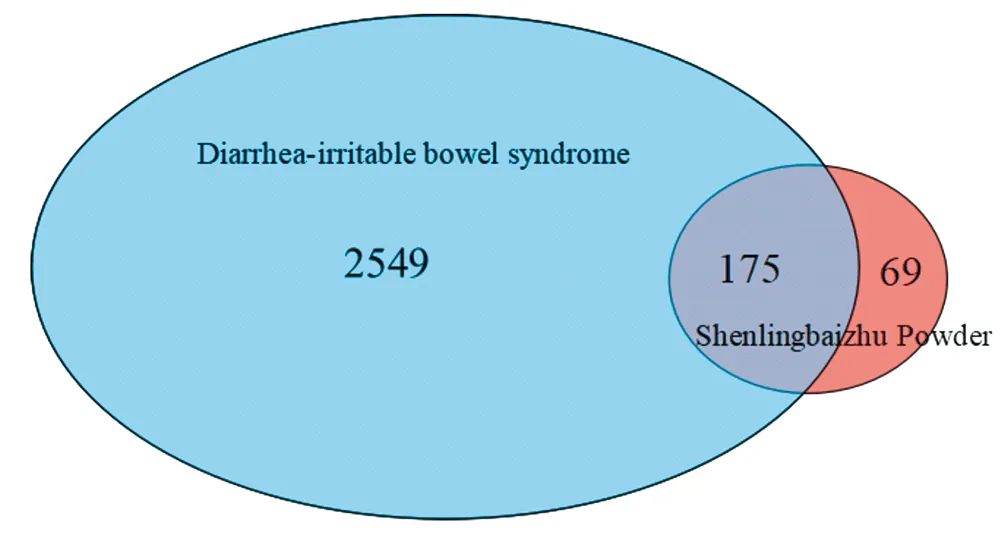
Figure 1 The active ingredients of Shenlingbaizhu powder and the Venny analysis diagram of IBS-D target

Table 2 Intersection targets of active compounds of Shenlingbaizhu powder and IBS
3.4 Regulation network analysis of Shenling Baizhu powder on IBS-D
Cytoscape software was used to visualize 184 active Shenling Baizhu powder and 175 action targets of Shenling Baizhu powder on IBS-D and the regulatory network composed of four factors of IBS-D disease, as shown in Figure 2.

Figure 2 The regulatory network of Shenlingbaizhu powder and its active components, IBS-D and Shenlingbaizhu powder on its effective target
The topological analysis results in Table 3 showed that the top 50 nodes contained 25 key compounds such as Quercetin Luteolin Kaempferol and 23 key targets such as PTGS2 ESR1 AR.
3.5 Construction of target protein interaction network (PPI network) and core gene screening of Shenling Baizhu powder against IBS-D
Figure 3 shows the protein interaction network (PPI network)of Shenling Baizhu Powder on IBS-D targets. The number of connection nodes of each target was counted, and the top 30 nodes were selected as the core genes in the protein interaction network,including AKT1, IL6 and JUN genes, as shown in Figure 4.

Figure 3 PPI network diagram of the intersection targets
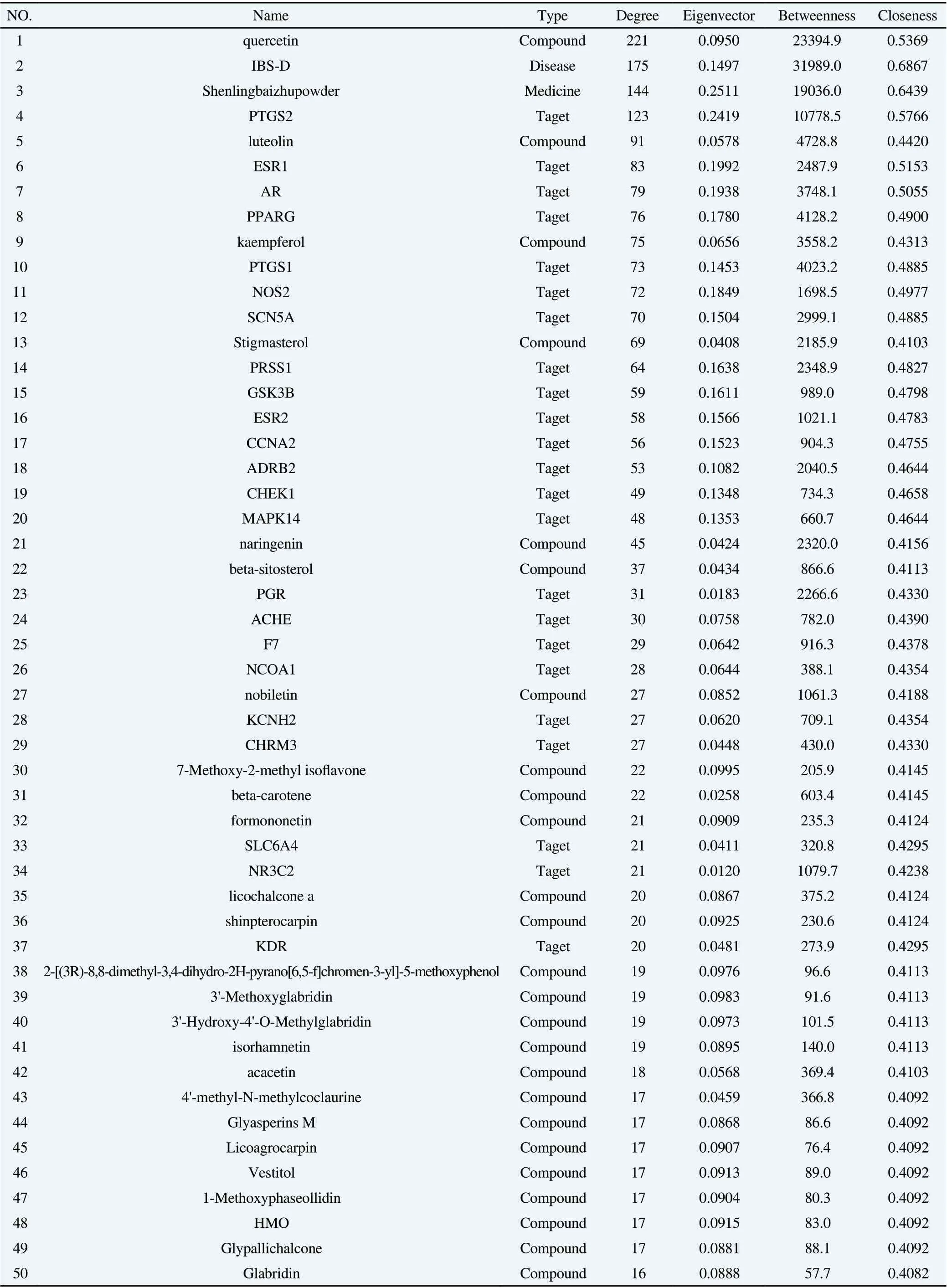
Table 3 Topology analysis results of regulatory network

Figure 4 Statistics of the number of nodes connected to some targets in the PPI network of intersection targets
3.6 Molecular docking
The targets in the top 50 nodes in the regulatory network and the four intersection targets PTGS2, ESR1, AR and MAPK14(PDB ID are 5KIR, 5ACC, 2Q7K and 5ETC, respectively) between the active ingredients of Shenling Baizhu Powder and the top 30 targets in the PPI network connection nodes are taken as the potential best targets in the intervention network, which are included in the top 50 nodes in the regulatory network respectively.
According to the results in table 4, among the 25 key compounds of Shenling Baizhu Powder, there are 12, 20, 23 and 5 of them whose docking binding energy with PTGS2, ESR1, AR and MAPK14 is lower than that of pinaverium bromide with the same target protein,and there are 4 potential core compounds whose docking binding energy with four target proteins is lower than that of pinaverium bromide, respectively. It indicated that there were many components in Shenling Baizhu Powder which had a good combination with IBS-D related protein network, that is, Shenling Baizhu Powder could intervene IBS-D with multiple targets.
3.7 Gene ontology (GO) enrichment analysis of Shenling Baizhu Powder on IBS-D
The GO enrichment analysis network of the target of Shenling Baizhu Powder on IBS-D involves 246 biological processes (BP),of which 92 processes have P-value < 0.01, and the 20 BP processes with the smallest P-value are taken as a graph, as shown in Figure 5, which shows that the intervention of Shenling Baizhu Powder on IBS-D process is most likely related to the transcriptional positiveregulation of RNA polymerase II promoter, exogenous apoptosis signal pathway without ligand, cytokine response, and so on.

Table 4Results of molecular docking
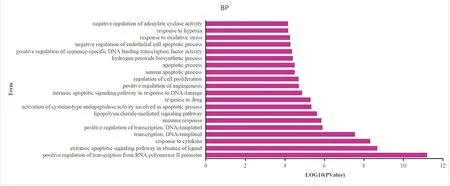
Figure 5 GO-BP analysis results
There are 33 kinds of cell components (CC) involved in GO enrichment analysis network, among which 18 kinds have P-value< 0.01, as shown in Figure 6. The results show that the intervention of Shenling Baizhu Powder in IBS-D process is most likely related to cell components such as extracellular space, cytoplasmic fluid,nucleus, extracellular matrix and plasma membrane.

Figure 6 GO-CC analysis results
There are 54 molecular functions (MF) involved in GO enrichment analysis network, among which 21 have P-value < 0.01, as shown in Figure 7, which shows that the intervention of Shenling Baizhu Powder in IBS-D process is most likely related to the molecular functions such as protein homodimerization activity, protein heterodimerization activity, drug binding, MAP kinase activity, heme binding and adrenaline binding.
3.8 Analysis on the KEGG pathway of Shenling Baizhu Powder on IBS-D
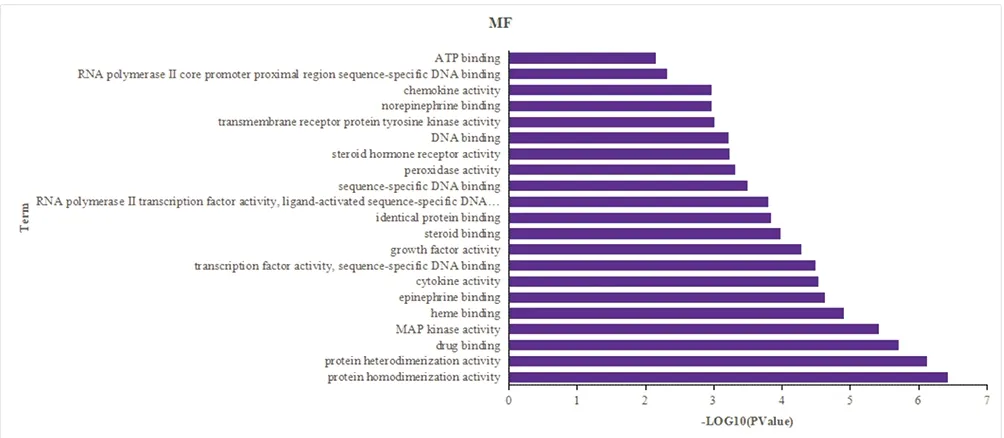
Figure 7 GO-MF analysis results
A total of 172 KEGG pathways were involved in the enrichment of Shenling Baizhu powder on IBS-D action targets, and the top 20 pathways were selected as bubble plots, as shown in Figure 7.KEGG pathway enrichment analysis results show that the three atractylodes scattered in IBS - D interventions most likely to be associated with Kaposi sarcoma-associated herpesvirus infection,Hepatitis B, Human cytomegalovirus infection, Fluid shear stress and atherosclerosis, AGE - RAGE signaling pathway, Hepatitis C pathway, Prostate cancer, TNF signaling pathways, etc. Typical pathway diagram is shown in Figure 8.
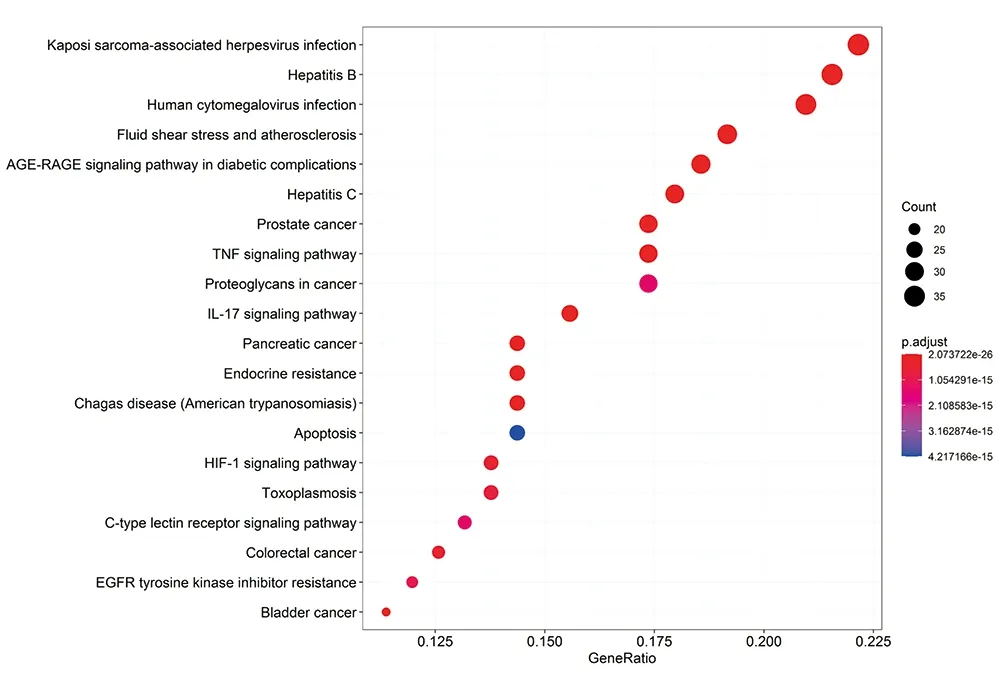
Figure 8 KEGG pathway enrichment analysis results

Figure 9 TNF signaling pathway diagram
4. Discussion
Shenling Baizhu Powder is the main prescription for treating IBS-D with spleen deficiency and dampness excess. It is composed of 11 medicines including ginseng, poria cocos, Atractylodes macrocephala koidz, white hyacinth bean, dried tangerine peel, yam,licorice, lotus seed, Amomum villosum, coix seed and platycodon grandiflorum. There are 184 active compounds and 175 targets that can act on IBS-D. Therefore, the arrangement and combination of intervention mechanisms for IBS-D are extremely rich. In the regulation network of Shenling Baizhu Powder on IBS-D,quercetin takes the first place among the core compounds with 221 connection nodes, followed by luteolin, kaempferol, stigmasterol and naringenin, which become the popular choice of effective compounds. On the other hand, the tARgets in the regulatory network are prostaglandin endoperoxide synthase 2(PTGS2),estrogen receptor 1(ESR1), androgen receptor (ar), peroxisome proliferator-activated receptor (PPARG) and prostaglandin endoperoxide synthase 1(PTGS1), which has the greatest probability to participate in the intervention process of Shenling Baizhu San on IBS-D .. In the interaction network of target protein of Shenling Baizhu San on IBS-D, protein kinase (AKT1), interleukin -6(IL6),JUN protein, mitogen-activated protein kinase 8(MAPK8) and signal transduction and activation transcription factor 3(STAT3) have the largest number of connection nodes, which is the most likely core in the regulation signal pathway of Shenling Baizhu San on IBS-D. In the top 30 core proteins, PTGS2, ESR1, AR and MAPK14 also play a dominant role in the regulation network of shenlingbaizhu powder on IBS-D, that is, they can not only receive the regulation signals of the effective components of drugs upward through multiple paths, but also conduct the received regulation signals downward to IBS-D .. Therefore, four tARget proteins, PTGS2, ESR1, ar and MAPK14, are the best potential target options for intervention of IBS-D .. According to the analysis of moleculAR docking results, it was found that the docking binding energies of quercetin, luteolin,kaempferol and isorhamnetin in 25 key compounds of Shenling Baizhu Powder with four target proteins, namely PTGS2, ESR1, ar and MAPK14, were lower than those of pinaverium bromide with corresponding target proteins. Therefore, the intervention effect of Shenling Baizhu Powder on IBS-D is better than that of Pivium Bromide in terms of the number of targets and the ease of binding with targets. Quercetin, luteolin, kaempferol and isorhamnetin are common bioflavonoids with antioxidant, anti-inflammatory and anticancer effects [3-9]. Prostaglandin endoperoxide synthase 2(PTGS2), also known as cyclooxygenase 2(COX-2), is an inducible enzyme, which plays an important role in pain and inflammation mechanism, and is one of the target molecules highly concerned by the pharmaceutical industry [10-11]. Estrogen receptor 1(ESR1)is a steroid hormone nuclear receptor and an important mediator of estrogen function. it mediates various diseases in human body,regulates physiological and pathological processes of reproductive,cardiovascular, skeletal, endocrine, nervous and immune systems,and is related to various endocrine-related diseases and various cancers [12-13]. Androgen receptor (AR) is also a steroid hormone receptor, which is widely expressed in human tissues. Like estrogen receptor 1, AR is related to many endocrine-related diseases and many cancers [14-16]; Mitogen-activated protein kinase 14(MAPK14)is a serine-threonine protein kinase that can be activated by different extracellular stimuli. MAPK14 can regulate the production of inflammatory mediators and control the proliferation, differentiation,migration and survival of cells. Its activation in endothelial cells leads to actin remodeling, angiogenesis and DNA damage, which has a significant impact on cardiovascular homeostasis and cancer progression [17-19]. Therefore, the intervention of Shenling Baizhu Powder on IBS-D is closely related to inflammation, cancer and endocrine disorders, and other related reactions and pathways. This is consistent with the conclusion that inflammatory reaction is involved in IBS-D in many studies [20-21]. The results of GO analysis showed that the intervention of Shenling Baizhu Powder on IBS-D process was most likely related to the transcriptional positive regulation of RNA polymerase II promoter, exogenous apoptosis signal pathway without ligand, cytokine response, DNA transcription and immune response, etc. The cellular components were most likely related to extracellular space, cytoplasmic fluid, nucleus, extracellular matrix and plasma membrane components, while the molecular functions were most likely related to protein homodimerization activity and protein heterodimer The results of KEGG pathway enrichment analysis show that the intervention of Shenling Baizhu Powder on IBS-D is most likely related to Kaposi's sarcoma-related herpes virus infection, hepatitis B pathway, human cytomegalovirus infection,blood flow shear stress and atherosclerosis, diabetes complications,AGE-RAGE signal pathway, hepatitis C pathway, prostate cancer,TNF signal pathway, etc., which is consistent with the above analysis and literature reports. To sum up, the intervention effect of Shenling Baizhu Powder on IBS-D is better than that of pinaverium bromide in terms of the number of targets and the ease of binding with targets. The intervention process of Shenling Baizhu Powder on IBS-D may be closely related to related reactions and pathways such as inflammation, cancer and endocrine disorders, among which quercetin, luteolin, kaempferol and isorhamnetin are the potential core compounds in the intervention network, including PTGS2,ESR1, AR and MAPK14.
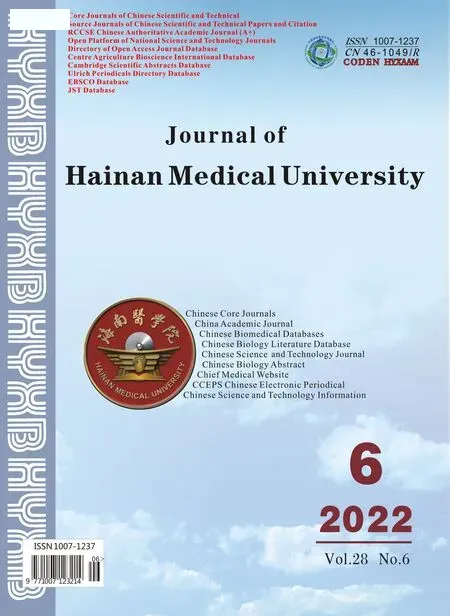 Journal of Hainan Medical College2022年6期
Journal of Hainan Medical College2022年6期
- Journal of Hainan Medical College的其它文章
- Systematic review of Shufeng Jiedu capsules for acute attack of chronic bronchitis
- Research on the possible molecular mechanism of Fructus cnidii to improve sleep based on network pharmacology
- Network pharmacological study and molecular docking verification of Capparis spinosa in the treatment of systemic sclerosis
- Effect of pestle intervention in type 2 diabetic peripheral neuropathy on Keap1 / Nrf2 / ARE pathway and the relationship with oxidative stress
- Experimental study on the effect of cryoablation on lung cancer mice based on MAPK/ERK signaling pathway
- Effects of Qishen Yiqi dripping pills-containing serum on KATP channel opening and PI3K/AKT signaling pathway in hypoxic/reoxygenated H9C2 cardiocytes
